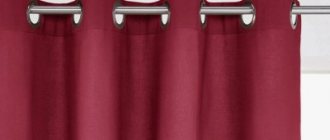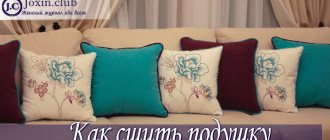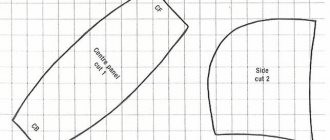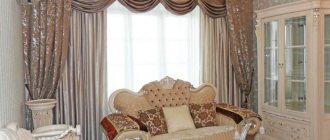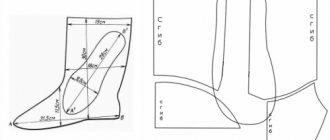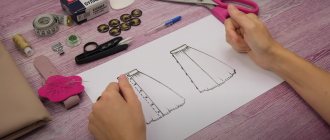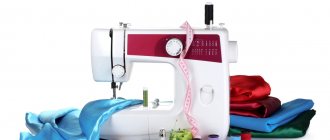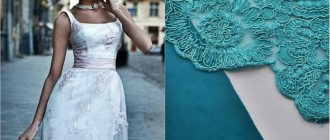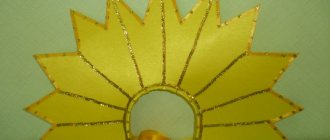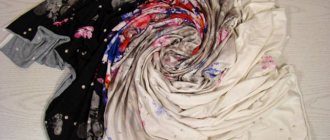Stores offer beautiful but standard curtains for decorating houses and apartments. But you want your own home to be not just cozy and beautiful, but unique and individual, reflecting the inner world of the owners and based on their preferences. There is one way to make such a dream come true without spending all your savings on it: sewing the curtains yourself. This task is within the capabilities of any person who has the desire to create. Tips on what exactly to create and how to do it effectively can be found in our article.
Ideas for sewing curtains: which curtains you can sew yourself
Ideas for your own creativity can be drawn from the history of curtains: from animal skins with which caves were hung to the lush decorations of palace halls with luxurious tassels, draperies and multi-layered compositions. Modern technologies make it possible to use new materials for curtains: wrinkle-resistant, non-flammable and not exposed to ultraviolet radiation. Current fashion trends regarding curtains return to the old days, when great attention was paid to textile decoration.
Curtains with lambrequin
Curtains with a decorative lambrequin are most often used in living rooms.
But, due to the fact that a lambrequin can not only decorate a window and give it a complete look, but also has quite practical functions: it hides cornices and curtain fastening systems - it can be used in all rooms.
The only condition is compliance with the style of the room in shape, choice of material and design. Lambrequins with draperies are appropriate in the central room; they will create an atmosphere of comfort and luxury in combination with other interior items.
A rigid lambrequin frame - a gang made of fabric or plastic - can be used in the kitchen and bedroom.
Roman style
The highlight of Roman blinds is a specific fabric made from noble types of dense fabric: jacquard, satin, muslin with a large geometric pattern or without a pattern. Practical Roman-style curtains in a modern apartment, designed in ethnic or minimalist style, look organic on the balcony, kitchen, bathroom and library, as well as in the living room and bedroom.
English style
For those who want to give their home an aristocratic spirit based on a combination of simplicity and nobility, English-style curtains will appeal. The basis of such curtains is a smooth rectangular fabric. Cords threaded through sewn rings are controlled by a lifting mechanism, thereby creating pleats: wavy, bow-shaped or puffed. The number of folds may depend on the size of the window opening or the preferences of the owners.
Classic
Classic curtains, made of two panels, are the simplest option, but also the most popular. Various methods of fastening: loops, ties, drawstrings, eyelets - make the classics not boring. By making classic curtains double-sided, you can increase their functionality and decorativeness.
From two long, even canvases, you can use various technical devices to create style compositions:
- "hourglass";
- Japanese curtains;
- Italian curtains.
The location of the curtains determines the choice of fabric, which can be the simplest: linen or chintz and the most respectable: brocade, satin, velor, wool.
French curtains
The curtains, based on the traditions of lush France, are gathered along the entire length to form narrow scallops. Such curtains are sewn - “awnings” from soft, elastic fabrics: tulle, satin, silk, voile, chiffon, organza. “Marquise” is a curtain for those for whom beauty in the interior is ahead of functionality.
Silk
Thanks to the silk material, the curtain looks rich. Silk is expensive, but this is compensated by the beauty and durability of the fabric. It hardly creases and leaves no creases. To extend the service life of silk curtains, you need to combine them with lining material.
Silk dyes wonderfully, the material has a rich color range. It should be taken into account that the material gets dirty easily and water stains are clearly visible. Most silks are dry cleaned.
Fabric consumption for curtains
The process of making curtains should begin with the purchase of fabric. Even if the choice is a simple model, it is necessary to correctly calculate the required amount of fabric for sewing.
The main parameters that you need to pay attention to are the width of the canvas and the direction of the pattern on it. If there is a desire to make drapery in your plans, use the assembly coefficient (CF), which is expressed in the ratio of the cut to the width of the finished curtain. To determine how much fabric to buy in this case, you need to multiply the finished width of the curtain by the KS.
CS depends on the type of fabric:
- for curtains it is 1.7;
- for tulle with a pattern – 2;
- for tulle without a pattern - 3.
Subtleties of the color palette
The production of exclusive curtains must begin with the selection of color shades. Take a detailed look at the interior of the room, pay attention to what color schemes predominate, whether there is a lot of furniture in the room, and also do not forget about minor details. After a detailed analysis of the design of your hall, find a compromise: curtains for the hall should enliven the space, visually expand it, fill it with pleasant color elements without disturbing the overall atmosphere of the room.
Every modern housewife can easily sew stylish and extraordinary curtains, as in the best magazines of 2021
If your living room is furnished with classic furniture and the wallpaper is neutral pastel, then the curtains should be cool and light, so light greenish shades or cool yellow ones will suit you best, which will make the room summer and sunny.
As for the more modern interior of furniture in light colors, the curtains can be chosen in bright and rich colors, for example, orange, green - but with this option it is necessary to dilute the interior with pillows or a bedspread in an identical range of curtains, which has been very popular for several years in a row, 2021 was no exception.
Curtains on a roll
The range of curtain fabric in rolls has three standard widths:
- 1.40 m;
- 2.80 m;
- 3m.
If the length of the intended curtain fits into the given width and the pattern is located from edge to edge, the fabric is calculated using the same formula as tulle: cornice width x KS (for curtains it is 1.7).
The calculation of the fabric will be different if the pattern is located along the edge and the width of the roll is less than the height of the future finished curtain. When sewing several fabrics together, you should remember to match the pattern between them. In this case, you will need more fabric - exactly 1 repeat, that is, a completed fragment of the pattern.
Cotton
An ideal material for decorating various windows. Cotton material is durable, wear-resistant, dyes well, and can be printed without any problems. Cotton fabric has different textures, thermal conductivity and drape properties. It is easy to iron, and the reliefs of the folds hold their shape perfectly. The curtains can be machine washed and dry cleaned.
Direction of the pattern on the roll
The direction of the pattern, or rapport, in a roll can be:
- from edge to edge;
- along the edge.
If the pattern on the roll has a transverse direction, then the width of the fabric is equal to the height of the finished curtain. Payment is made per linear meter of curtain width. This option is suitable if there is a need to make a curtain for a very wide window.
If the pattern is directed along the roll, then the width of the fabric is equal to the width of the finished curtain. Payment is made per linear meter of curtain height. This option limits the width of the curtain, but is suitable for sewing curtains with a ceiling of any height.
Nuances of measurements
To get a beautiful pattern for curtains, you need to make accurate and accurate calculations. A few tips to follow when taking measurements:
- The height should be measured in two or three places. If the ceiling or floor in the room is uneven, such a check will reveal this. If the heights are different, during the work you need to make a bevel in accordance with the measurements.
- You cannot subtract allowances from the result, since this is already done during the pattern.
How to make a pattern
If the idea of ready-made curtains has formed in your head, everything you need for sewing is ready, you should go to the store to buy fabric.
It is first necessary to make calculations so that the money spent on the purchase of fabric is not wasted: due to a shortage or excess of material.
Fabric calculation examples
To calculate the fabric you will need the following parameters:
- the height of the product equal to the distance between the floor and the curtain rod hooks, minus the distance between the floor and the lower edge of the curtain;
- a width equal to the length of the cornice - from one extreme hook to the other.
So, we determine that the height of the finished product will be 2 meters 60 centimeters. The width of thick curtains will be 5 meters 10 centimeters, according to calculations: 3 * 1.7 = 5.1, where 3 m is the length of the curtain rod, and 1.7 is the gathering factor recommended for this type of fabric.
In the store we purchase fabric 5.1 m long with a standard roll width of 2.8 m.
Making a lambrequin
Lambrequin can be soft, hard, combined and figured. Soft is made from thick or thin fabric. Decorated with sewn elements, folds and textile details.
The hard one is distinguished by a corresponding lining, which can be wooden or plastic. It gives shape and decorativeness to curtains. The figured lambrequin has a three-dimensional pattern and various holes.
When preparing, you need to make a pattern. Popular options are available on the websites. Then fabric of appropriate sizes is purchased. Initially, the canvas is attached above the window and sewn to the length of the floor. Then for a cornice half a meter wide you will need seventy centimeters of fabric.
Do-it-yourself tulle - step-by-step instructions on how to sew beautiful tulle. Photos of ready-made ideas and modern designCurtains for gray wallpaper - options for the ideal combination of curtains in a gray interior (TOP-150 photos of new designs)
- Quilt - 130 photos of the best new items of 2021. Step-by-step instructions on how to sew a beautiful patchwork quilt with your own hands
The lining should be trimmed. Having temporarily connected the layers with a pin, turn the curtains over and cover the holes. Then the cornice is attached, and the folds are tightened with laces.
Uncover
Before you start cutting, to avoid subsequent shrinkage, you should wet the fabric, squeeze it lightly and leave it wrapped in a towel for several hours. Then take out the fabric and iron it from the inside out.
Prepare the necessary tools:
- large scissors;
- a piece of soap;
- safety pins;
- meter;
- ruler.
When cutting parts, it is necessary to focus on the direction of the grain thread so that the product does not deform during operation. Cutting start with large canvases:
- Lay the fabric on the floor, wrong side up;
- Place the pattern pieces on the fabric.
- Trace them with soap, taking into account a 1cm seam allowance.
- Leave 10 cm at the top and bottom of the canvas.
- Leave 4 cm for processing the sides.
Types of curtains for sewing
First you need to decide on the type of curtains. Among the many, there are eight main types. Some are similar and differ only in nuances.
For beginners, the following popular styles are recommended for familiarization: English curtains, Roman curtains and classic ones with laces. The pattern for such curtains is perfect for beginners. Next, you should prepare the fabrics and tools.
Straight curtains have a weak effect, but are suitable for rooms with simple decoration and small windows. They are often complemented with laces made from the main fabric, sometimes with tassels. It is common to place a hook in the wall to maintain shape.
Fabric hem
To ensure that the result does not disappoint, it is very important to correctly fold the fabric, according to the rules:
- A double hem makes the edge of the curtain even, but it is not suitable for curtains with interfacing.
- Basting should be done with long stitches to avoid deformation.
- Before ironing the hems, it is better to secure the curtain with pins.
- Before hemming the bottom edge of the curtain, let it hang for a couple of days.
Hemming can be done using a sewing machine with a zigzag stitch, adhesive tape, or by hand using a hem or blind stitch.
Useful tips for beginners
- To ensure an even stitch, attach tracing paper with seam markings and stitch directly across the paper.
- If you use bias tape for the side seam, then use clips like clothespins - they will help you avoid the fabric shifting.
- Don't forget to use the sewing machine to secure the seam so that it doesn't fall apart.
- Remove any unnecessary threads from the seams to keep the garment looking neat.
- If the seam is crooked, it’s better to rip it open and do it again, don’t be lazy.
- Use accurate calculations, with cm allowances marked.
- Don't forget to steam iron your curtains.
Curtains with hinges
Curtains with hinges are an option for framing windows in a studio apartment of a young family, a kitchen space or a nursery. The peculiarity of this type of curtain is that, apart from the fabric, no additional devices are required. A hinged curtain is a processed fabric with decorative loops.
A step-by-step master class will help you understand the intricacies of this simple process:
- Cut out 2 pieces of fabric using the above cutting technology.
- Sew the upper part of the fabric, preparing a piece - a strip of fabric with a length equal to the width of the curtain and a width of 10 centimeters.
- Glue non-woven tape onto the strip.
- Hem the curtains at the top and bottom, turning the edges inside out twice.
- Determine how many loops you will need, taking into account that their standard width is from 6 to 7 cm.
- Prepare the blanks, taking into account that the width of each blank will be equal to: 6*2+1.5=13.5 cm.
- Fold each piece in half, wrong side up.
- Sew, retreating from the edge 1.5 cm.
- Turn right side out and fold so that the seam is at the back.
- Make markings on the canvas for the location of the loops.
- Place the loops on the front side of the fabric with the cuts facing up and secure with pins.
- Place a strip of fabric prepared for facing on top and stitch along the top line, retreating 1.5 cm from the edge.
- Fold the strip to the wrong side, iron and baste from the wrong side.
- Thread the loops onto the cornice.
Making roses
There are two common options:
A decimeter wide fabric is taken, the length does not matter much. Only the splendor of the product depends on it. The strip is folded in half lengthwise. The stitching is then started and the edges are sewn together. The workpiece is turned out, twisted and fastened with threads. The method is simple, and even a child can make such a rose.
The flower is assembled from individual petals. Round petals of different sizes are cut out. You shouldn’t make them perfectly even - asymmetry is inherent in nature.
To avoid fraying of the edges, the petals are treated with fire. The result is interesting and more natural, but you need to put in more effort.
Other elements. There are many decorations for curtains. The most popular ones are listed here:
- jabot (specially shaped folds for additional decoration);
- tiebacks (patterning curtain tiebacks helps you make beautiful draperies with your own hands);
- decorative tassels (they add elegance to even ordinary simple curtains and can be used as tiebacks).
How to sew curtains with ribbon
Curtains on ribbons specially designed for draping and hanging on curtain hooks are the simplest option for window decoration. Simplicity of design is in no way related to decorativeness, which is ensured through the selection of fabric, trim and accessories.
First of all, you need to measure the width of the cornice and the height from the floor to the cornice, and take into account the fabric for the top and bottom trim. Create a pattern and prepare two identical fabrics.
The curtain tape is sewn according to this algorithm:
- Lay out the fabric with the wrong side up, and apply the tape also with the wrong side up on the top edge of the fabric.
- Carefully fold the top edge 2-3 cm, catching the edge of the braid.
- At a distance of half a centimeter from the fold, stitch the top of the ribbon, then the bottom of the ribbon.
- Release the cords, fold the side edges of the fabric 1.5-2 cm over the braid and stitch.
- Iron the finished curtains, observing the temperature conditions.
- Tighten the cords, forming even folds across the entire width of the curtain.
- You can do without additional costs and hang the curtain from the loops located on the tape on the hooks located on the cornice.
The classic version of curtains with hinges can be diversified with interesting hooks. You can make them from soft toys, artificial flowers and decorative ribbons.
Embroidery will turn a simple curtain into a designer one.
The work invested in creating a cozy family nest will be justified by the admiration and respect of loved ones.
Stitching elements
How to sew curtains with elements correctly? There are several options for how to sew elements with curtains. Usually it is curtain tape, fabric loops, ties.
- With curtain tape, everything is simple - you bend the edges of the curtain tape so that it does not crumble and stitch along the hem of the curtains from above.
- Fabric loops have different shapes, so the pattern is constructed in the form of a rhombus, rounded, rectangular.
- Ties are ribbons of different lengths that are attached at your discretion at any distance and of any length.
Sewing these elements is a process where only the fold ratio is taken into account so that the curtains hang beautifully.
Selecting curtain rods
Gone are the days when curtains were hung on a string. Sewing a curtain by investing effort, time, and imagination into it is half the battle. It is also necessary to select a cornice that will not only allow you to attach the curtains, but will also create a harmonious duet with them: it will emphasize the beauty of the curtains and enhance the visual effect. Maybe it will just become a reliable mount that will be completely invisible.
The usual round cornices, the basis of which is a pipe, are a classic of the cornice genre. This type of cornice is a self-sufficient element of the interior. Made of wood, natural color or tinted, with decorative carvings and vintage fastenings, it goes well with heavy curtains of noble colors and shades, made in a classic style without an abundance of decoration.
String cornices are a solution for fans of high-tech style and minimalism. These are inconspicuous designs, without a hint of decorativeness. Curtains made of modern materials: light, metallized, simple and at the same time elegant will take their rightful place on it.
Cornices made of aluminum profiles successfully combine high practicality and uncomplicated decorativeness. Their main advantage is any size and ability to take any shape. Curtains made of light fabrics look elegant on them, but they can successfully withstand any dense fabric. Curtains on such curtain rods play a “solo” role. You should only take into account the combination of cold aluminum with fabric colors in soft pastel colors and a copper shade of “demanding” gold, purple and burgundy.
Baguette cornices, richly decorated with stucco, carvings, made of natural wood or high-quality artificial materials, are intended for formal rooms decorated with curtains made of velvet and brocade, the finest organza and tulle. The cornice, in which all the fastenings are hidden under the decorative strip, should fit into the interior with heavy furniture and antique paintings.
If the baguette is white and smooth, it is a completely suitable option for a bedroom with Japanese-style curtains - simple ones made of unbleached linen.
Forged - works of blacksmithing, can be powerful, with deliberately rough processing.
They can be very thin with openwork elements.
These designs fit well into modern and traditional styles. Curtains that contrast in style, color and texture will look especially impressive on such cornices. Light weightless tulle will only benefit from a metal background, and a heavy velvet curtain on heavy forged rings in a wooden house will be a bright accent that completely transforms the space.
When selecting cornices for curtain masterpieces created with your own hands, it is also worth showing your imagination, moving away from stereotypes and creating your own unique ensemble.
Blinds
This option is stylish and easy to manufacture. For blinds, a dense canvas without patterns is used. First you need to decide on the size and number of lamellas. The standard values are 127 and 89 millimeters.
Then the lamellas are cut out according to calculations. Allowances are also taken into account. The lamellas are placed with the front side inward, and the stitches are started. After turning them inside out, they are ironed and put on the guides.
How to hang curtains
To hang curtains correctly, you need to understand the mounting methods. The most common in terms of simplicity, reliability and invisibility are hooks, most often plastic. They are attached to the curtain and cling to the curtain rod. They can withstand any type of fabric, but are not durable. If they break, they are easy to replace, as they are affordable.
Clips are fabric clips that have teeth. They withstand curtains better, but their drawback is that they can damage the fabric with sudden movement.
Eyelets are special rings sewn into the fabric that make it possible to easily string the curtain onto a tubular cornice. The curtain will be securely fastened, and the waves of the fabric will stand in a strict geometric order. This type of fastening is suitable for all rooms; inserting rings into the fabric is not difficult. Eyelets are designed for durable fabrics; metal will weigh down light fabrics.
Decorating your own home is an activity not only for a housewife, but also for a real lady. Using recommendations and advice, anyone can handle sewing stylish curtains in their free time. In an interior in which soul and effort are invested, the quality of life improves.
Eyelets
Curtains with eyelets look very modern, but installing the rings requires a special tool; at home it is quite difficult to achieve high quality workmanship.
Photo gallery
Tools and accessories
Before you sew curtains yourself, prepare the usual set of tools and accessories that you probably already have if you love and know how to sew. If this is your first experience, we advise you to check their availability even before you start cutting your future curtains.
Below is a list of what items you need to take care of before sewing beautiful curtains with your own hands.
Sewing machine . Choose models with a zigzag function, as well as with a special buttonhole foot. Of course, if you wish, you can sew on a regular sewing machine - the main thing is that it can perform at least one type of stitch. However, it is much more convenient and faster to learn to sew on a modern device equipped with various devices.
Rulers . It is best to have in your arsenal several rulers of different lengths (1 m, 50 cm and 20 cm) and a square. The divisions on them should be bright, since often the count is in millimeters and you can make mistakes with the calculations.
Pattern . This is a tool that allows you to draw more precise curved lines. Used to draw rounded sections of a product.
Tailor's chalk . Crayons come in different colors and are used to create patterns on fabric. If there is no chalk, a thin dry soap can successfully replace it. The edge of the chalk or soap should be sharp enough. Don't worry about them leaving a mark on the fabric. As a rule, chalk or soap lines disappear after the first ironing of the finished product.
Tape measure . Choose a tape with bright and clearly marked divisions.
Scissors . It's good if you have several pairs of well-sharpened scissors on hand. First of all, you will need special large tailor's scissors designed for cutting fabric. They are designed in such a way that their lower blade does not lift the fabric during cutting. Small scissors will be useful for cutting threads. You will need paper scissors to cut out the paper pattern.
Pins . Used for fastening parts. Choose DIY curtain pins with colorful heads that are easy to find on the floor.
Sewing needles for handmade work . You need to purchase a set of needles with different numbers. Thin needles are intended for thin fabrics, and thick needles are for heavy and dense fabrics. In addition, you need to take into account that short needles are intended for making small stitches and seams, and long ones are for basting.
Machine needles . Their thickness depends on the density of the fabric. So, needles No. 60-70 are intended for thin fabrics, and No. 90-110 - for thick ones. In addition, you need to pay attention to the tip of the needle. Round tip needles are designed for jersey and knitted fabrics, while pointed needles are for thicker fabrics such as denim or teak.
Threads . They are selected depending on the purpose - either to match the fabric, or in a contrasting color, for example, for stitching. Inexpensive threads are used for basting. Thick threads are used for finishing seams and buttonholes, and thin threads are used for darning and machine embroidery.
Seam ripper . This convenient device, which the seamstress must have at hand, is used for cutting loops and ripping seams. With its help, you can safely rip uneven stitching or straighten a corner.
Thimble . The device is selected according to the size of the middle finger. Not everyone uses a thimble, but when sewing curtains for beginners, it is necessary. In addition, if you adapt to the thimble, then during manual work it will be possible to push the needle into the thickness of the fabric.
Iron. It is best if it is a model with steaming and humidifying functions. You will also need an ironing iron (for example, a piece of gauze) in order not to damage the fabric during ironing.
These are the main tools and devices that you need to prepare before sewing curtains yourself; without them, it’s unlikely that anything will work out. However, to make your work as easy as possible, you can add a few more sewing accessories to this list.
Measurements are strips of thick paper with markings in the form of horizontal divisions equal to seam allowances. Usually this is a marking from 0.5 to 5 cm. During work, one side of the measuring tape is applied to the product at a given level, obtaining equal seam allowances.
Spray bottle for wetting products during heat treatment using an iron.
A peg for straightening corners on parts.
Ring with a knife for cutting threads (put on the finger).
Cutting board . Although it is more convenient to cut products on the floor, not everyone has this opportunity, but with the help of a board made of plywood, you can do this in any conditions.
Ironing board with a so-called sleeve . Without it, heat treatment of products seems difficult.
An overlocker is a machine for sewing cuts and processing elastic materials.
And this is also not a complete list of equipment for sewing curtains, but at the initial stage this will be enough.
